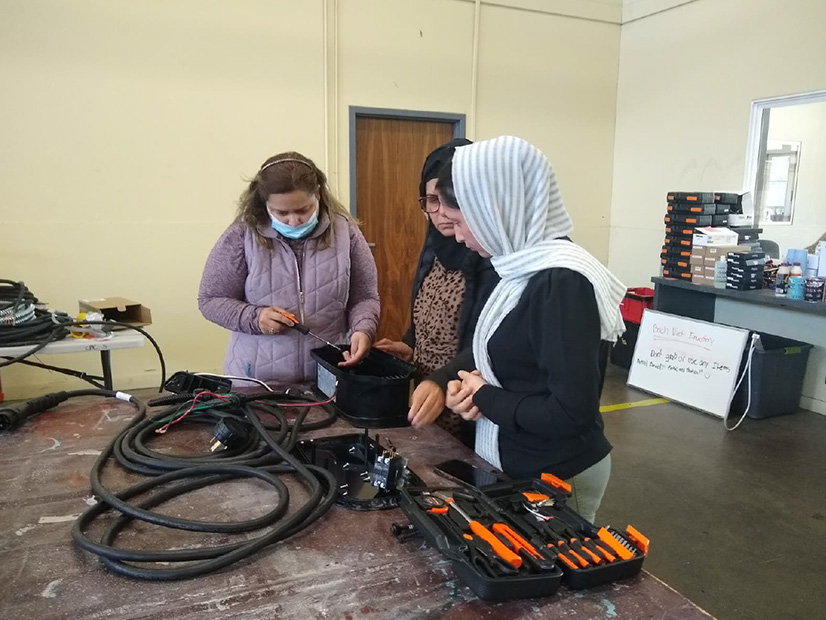
California officials on June 25 outlined how their agencies plan to address the shortage of skilled workers needed to support the state’s transition to zero-emission vehicles (ZEVs).
The state’s Workforce Development Board (CWDB), Employment Training Panel (ETP) and Air Resources Board (CARB) were among the several agencies that presented their approaches to workforce development during a Clean Transportation Program workshop hosted by the California Energy Commission. The program receives up to $100 million annually to fund ZEV infrastructure and development. (See Calif. Clean Transportation Program Needs Equity Emphasis.)
Also participating was the Governor’s Office of Business and Economic Development (GO-Biz), which leads the state’s ZEV Market Development Strategy, designed to be a “north star” for meeting the state’s goals, according to Gia Vacin, deputy director of ZEV Market Development at GO-Biz. The strategy outlines four pillars supporting the development of a successful ZEV market: vehicles, infrastructure, users and workforce.
Agency officials emphasized the need to develop “high-road” — or living-wage and skills-based — careers and opportunities for disadvantaged communities in the ZEV industry.
“We can’t succeed in these other pillars without the support of a robust and thriving workforce that can help lift these others up,” Vacin said. “As we assess our current and future workforce needs, we are really thinking about this ecosystem and standing up and maintaining the entire market.”
In 2020, the CEC and CWDB partnered in a joint memorandum of understanding to coordinate economic and workforce development planning related to the state’s clean transportation goals, with an emphasis on increasing job opportunities for disadvantaged populations.
“The Workforce Board has spent the last several years really advocating to do better in the state of California and the Energy Commission has become a really good partner, especially given the [number] of investments that are being made through the department,” said Derek Kirk, assistant deputy secretary of climate at the state’s Labor and Workforce Development Agency. “The reality is, not a whole lot of that money is flowing directly through the workforce agencies or any of our workforce development partners, and so it’s incumbent on us to build relationships across the board to leverage our expertise and to start identifying those programs that can be leveraged to support the creation of this new workforce.”
As part of the partnership, the CWDB assigned liaisons to the CEC to provide the latter with workforce expertise in labor development strategies and policy and technical assistance and to help identify resources and opportunities. Kirk highlighted the CWDB’s High Road Training Partnership Resilient Workforce Program, designed to increase access to high road jobs for underserved populations, which developed opportunities such as the Jewish Vocational Services 18-week Automative Pre-Apprenticeship Program in partnership with the City College of San Francisco.
Robert Meyer, director of economic development at the ETP, which uses a pay-for-performance contract to reimburse costs for customized job skills training, said his agency will fund nearly $95 million in training for fiscal 2024/25. The CEC and ETP are currently formalizing an interagency agreement to increase the number of Electric Vehicle Infrastructure Training Program (EVITP) certified electricians needed to support widespread transportation electrification. Both agencies established a goal of allocating the ETP $3 million in CTP funds to offset training and EVITP certification costs.
CEC staff also highlighted the Inclusive, Diverse, Equitable Accessible and Local (IDEAL) ZEV workforce pilots, one of which awarded $6.5 million to 14 projects for high school and college students, veterans and disadvantaged communities, as well as the ZEV Sustainable Equitable Employment Destination (ZEV SEED) project, which targets training workers in disadvantaged communities in Sacramento County.
Equity Considerations
While investing in workforce training programs is important, the state should do more to consider equity gaps and the barriers some communities face in accessing these programs, said Eileen Tutt, executive director of the Electric Transportation Community Development Corp.
“We offer all these opportunities equally to various communities, and we are not recognizing the different needs in especially low-income, disadvantaged communities,” Tutt said.
Tutt identified the “gaps” some residents face in participating in training programs, such as a lack of a driver’s license, and reliable transportation, and encouraged state officials to use a portion of the funding to pay participants for taking time off from jobs or obtaining mobility.
“There’s just costs associated with this training that are not manageable for some communities,” she said.
Representatives from the International Brotherhood of Electrical Workers (IBEW) were frustrated the union wasn’t included in the workshop and said investing in ZEV infrastructure trainings and apprenticeships is a “waste” because the union already provides enough to support the industry.
“I am astounded that IBEW wasn’t included as an industry partner or expert or highlighted in today’s workshop,” said Gretchen Newsom, the union’s international representative for government affairs. “We’ve been training our members on EVITP many, many years ahead of the EV revolution. Why not layer this EV operations and maintenance training and knowledge onto the existing high road career as electrician?”
Echoing Newsom’s comments was Alex Lantsberg, research and advocacy director at San Francisco Electrical Construction Industry, the Labor-Management Cooperation Committee of IBEW Local 6 and the San Francisco Electrical Contractors Association.
“Rather than just simply a lack of IBEW … what it appears to me is that the state is trying to approach this training question in a very decentralized, uncoordinated way, throwing a bunch of money at a bunch of different programs and hoping they work,” Lantsberg said.
“IBEW contractors have extensive institutional memory and institutional capacity to train thousands of workers,” he said. “We’ve demonstrated in a variety of different contexts that there are plenty of EVITP certified electricians to be performing this work. What’s absolutely needed and what hasn’t been discussed is an affirmative pathway developed by the state to put those apprentices and to put those skilled and trained contractors on these jobs.”

